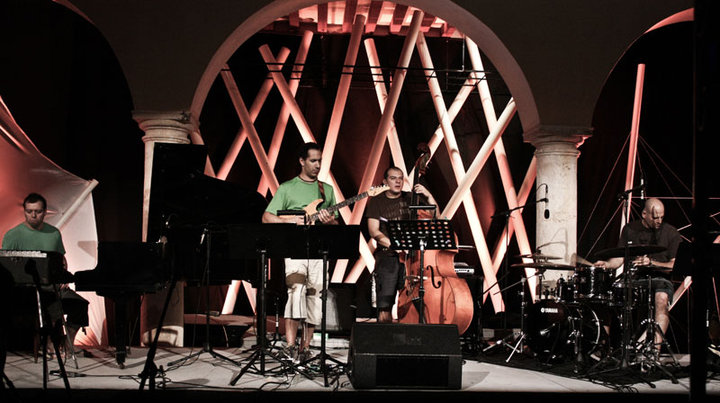Nearly eight years ago, Mark Aanderud, a Mexican-born pianist and composer, joined forces with Hernan Hecht (an Argentinian drummer). Their chemistry was instantaneous and natural. Aanderud says that the first things they did were related to free music. We have an incredible amount of magic in the way we can record music and play concerts without ever speaking about music. This allows us to never repeat ideas or suppress our creativity. This hasn’t changed over time.” The two friends formed Mole (pronounced Molay), a thrilling quartet that’s redefining contemporary jazz with the release of What’s the Meaning? on RareNoiseRecords. Hecht, who is also part of RareNoiseRecords’ band Brainkiller, says that this project was an obvious spot in his career. It is our version contemporary jazz. The sum of everything we’ve experienced and heard in our lives about jazz and all other arts. It is a freedom to express yourself, and not influenced by traditional jazz or any traditional line of language learning. “I am interested in music that is wide, not determined by any style.” Although both Aanderud, and Hecht would be horrified at the idea of Mole being called a fusion band Mole actually blends a variety music styles from jazz and rock to classical and funk, and even hip-hop. Aanderud says, “I don’t like the fusion idea, but it’s normal to think it sounds fusion a bit with all the electronic elements and grooves in our music.” “But I see us more along the same lines as Phronesis and e.s.t. Kurt Rosenwinkel, and in electronic music, groups such as Sigur Ros, Massive Attack, and Radiohead.” Aanderud, Hecht started inviting other musicians into their inner circle, to see how their music was affected. Hecht says, “We considered the possibility to work with more people in order to achieve different characters and sounds and experience new artistic opportunities.” “So I initiated tours and recordings together with Tim Berne and Rick Parker, Eli Degibri and Jonathan Kreisberg. Marco Renteria and Aaron Cruz were also involved. Always with the desire for novelty,” says Hecht. Aanderud and Hecht hired David Gilmore, a New York guitarist whose impressive credits include tours and recordings with Don Byron, Trilok Gurtu, Wayne Shorter and Steve Coleman’s Five Elements. Hecht says, “When we decided that we would tour with someone from New York, to have different sounds and pressure, someone from whom to learn with an shared philosophy and professionalism. Aanderud adds, “There’s probably no other guitarist with as many different grooves, time, and a free approach as him.” It was clear that he was the right one for us. Jorge “Luri”, a Mexican upright bassist, is the fourth member of the group. Jorge “Luri,” Aanderud first met in Mexico years ago. The keyboardist, who currently resides in Prague, says that he has known Luri since he started playing jazz music. “We were still children and we started to like this music. Hecht was a straight-ahead player, but he quickly became one of my favorite rhythm players and an amazing musician who can understand any musical situation. Hecht switches gears between driving drum ‘n bass to driving swing, and sensitive, colorful rubato playing. Hecht, who has lived in Mexico City for 16 years, states that his approach to the instrument is influenced by many different influences. While many drummers are an important part of my training, I don’t listen to what they play. The music and the depth of the communication are what I love, not my instrument. I enjoy the interaction between the instruments so it is possible that some of my playing is more influenced or influenced by a piano player than a drummer.” “PB” opens with free-form textural improvisations. Then, the theme is played at irregular intervals between Aanderud’s Wurlitzer electric keyboard and Gilmore’s warm-toned, electric guitar. Molina’s steady upright bass sound and Hecht’s loose, melodic playing around the kit make this piece a groove. Gilmore’s six-string work is fluid and expressive, with Wes Montgomery-style octave playing in his brilliant solo. Hecht is let loose at the end, bouncing around the kit with unbridled energy and lots of ideas. Hecht’s energetic drum ‘n bass beat fuels the hard-hitting “Stones”, while Aanderud adds classically-inspired lines to Aanderud’s grand piano. The moody “Trees and The Old New Ones” opens in a quiet tone with Molina’s bowed basse setting a droning ambience. Dorota Barova is his guest cellist and creates a latticework sound that resembles a chamber. Aanderud’s classical roots are revealed on this waltz-time number. It is accentuated by Hecht’s sensitive, swirling brushwork, and Gilmore’s deliberate, warm-toned guitarist lines. “Flour Tortilla Variation”, a rock-tinted workout, is marked by Aanderud’s powerful piano motif and Hecht’s sizzling drum ‘n’ bass groove. Gilmore unleashes an aggressive guitar solo that will delight six-string enthusiasts. The title track, which is darkly droney and focuses on minimalism, also highlights the indelible rhythmic connection between Aanderud and partner Hecht. Mark adds a calm quality to the track with his controlled piano solo, while Gilmore brings the music to life with rare fretboard abandon. This dynamic offering is cathartic. “Greenland” features hypnotic, tense jams that feature torrents of difficult unison lines from Aanderud u0026 Gilmore over a strong groove by Hecht u0026 Molina. Gilmore adds more heat to the throbbing jam with another distortion-laced solo, while Aanderud gives it a Wurlitzer solo to bring it to a higher level. Gilmore plays the accelerated finale, “Grubenid”, and uses some of the funk lines he learned as a member Steve Coleman’s Five Elements. Hecht provides the funk with smooth, syncopated backbeats while Molina anchors it with his bubbling bass beat. Hecht and Aanderud made a huge leap in their long-standing partnership with Mole’s bold debut, What’s The Meaning. http://moleband.com
